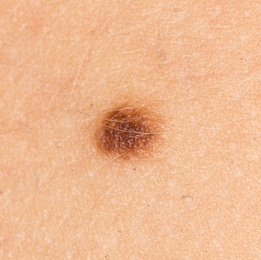
Are you concerned about an infected mole? We’ll tell you about the signs of infection and what to do about an infected or inflamed mole. You should know, though, that moles rarely become infected. They are most likely to become infected if they’ve been bleeding, but moles rarely bleed, either. If you do have a bleeding mole, you should see your doctor as soon as possible. You can read more about bleeding moles here.
What Causes Moles to Become Infected?

Moles rarely become infected, but when it does happen, it’s usually because the skin has been broken in some way. Maybe the mole has been scratched in some way, either because it itches so you’ve been scratching it or because it was scratched accidentally. Or maybe you’ve been picking it. Then bacteria get into the body and infection can set in.
Don’t pick moles if you can avoid it, as it can easily lead to infection and scarring. Read more about picking moles here.
If you have a mole that has been scratched or is bleeding, keep the area clean. That can help prevent infection.
Signs of an Infected Mole

Signs that a mole might be infected include:
- Redness
- Swelling
- Inflammation
- Pain
- Bleeding or discharge from the mole
- Fever
If you notice signs of an infected mole, you should see a doctor as soon as possible. You may need antibiotics to treat the infection and you’ll want to address it before it gets worse. Beyond that, infected moles are not common so you’ll want to have a doctor look at the mole to determine what’s causing it to become infected. A bleeding mole can easily become infected, but most moles do not bleed and a bleeding mole can be a sign of something more serious, so it should always be examined by a doctor.
Treating an Infected Mole
If you have a mole that has become infected, you need to see a doctor. Your doctor may prescribe antibiotics to take orally to treat the infection or he or she may recommend using an antibiotic ointment on the infected area. Very severe infections may need to be treated with intravenous antibiotics. Your doctor can also clean the area if needed.
Since moles rarely become infected, your doctor may want to biopsy the area to make sure it is just a common mole and nothing more serious. To biopsy a mole, a doctor just takes a small tissue sample and sends it to a lab for testing. The procedure can usually be done in the doctor’s office. Keep in mind the fact that most moles are benign, non-cancerous, and nothing to worry about (1). Get an infected or inflamed mole checked out by a doctor, but don’t be overly concerned until you hear what your doctor thinks about it.
Until you get to a doctor, keep the area clean and dry. If there is any bleeding or discharge from the mole, cover it with a clean adhesive bandage. Use an over-the-counter pain reliever as needed for pain or fever. Make an appointment with your physician as soon as possible, though.
If you have an inflamed or irritated mole in an area where clothing or jewelry will rub against it, causing irritation or even bleeding (such as a mole on your wrist where you wear a watch or a mole on your waist where the waistband of your pants would rub it), consider forgoing jewelry or wearing different clothing (like a dress instead of slacks) or covering the mole with a bandage to protect it.
Removing the Mole
If you have a mole that gets infected, you may wish to have the mole removed, especially if it becomes infected repeatedly. Your doctor can remove it with a minor surgical procedure and if the mole needs to be biopsied, he or she may just remove the whole thing at that time.
If the mole doesn’t need to be biopsied, you may prefer to avoid a surgical procedure. In that case, we recommend a topical treatment for moles called H-Moles Formula. Made in the U.S.A., it contains a unique blend of homeopathic remedies and natural essential oils that remove moles painlessly and without scarring. H-Moles Formula is not a treatment for infection, so if you have a mole that is infected, you still need to see your doctor for that. H-Moles Formula is available without a prescription, though, and it’s easy to use at home. Just follow the link to learn more.
